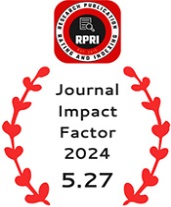Critical Analysis of Gaps in the Clinical Establishments Act, 2010: A Policy Implementation Perspective
DOI:
https://doi.org/10.55544/ijrah.5.3.5Keywords:
Healthcare regulation, Policy implementation, Clinical Establishments Act, Health policy, Healthcare quality, Federalism, Regulatory complianceAbstract
The Clinical Establishments Act (CEA) of 2010 represents India's landmark attempt to standardize healthcare regulation nationwide, yet its implementation has been characterized by significant disparities and systemic challenges. This policy analysis examines eight critical gaps in the CEA's design and implementation, documenting both structural limitations and procedural shortcomings that have hindered its effectiveness. Using an implementation science framework, we analyze how federalism challenges, enforcement limitations, rural provider burdens, absent patient protection mechanisms, and digital integration failures collectively undermine the Act's potential. Our findings reveal that while the CEA provides an important regulatory foundation, its impact is seriously hampered by patchy adoption, weak enforcement mechanisms, disproportionate burdens on smaller providers, and failure to address key dimensions of healthcare quality and access. We propose targeted reforms including tiered standards for different facility types, integrated digital compliance mechanisms, mandatory patient grievance systems, price transparency requirements, and harmonization of overlapping regulations. This analysis provides essential context for understanding regional implementation variations and developing more effective, equitable approaches to healthcare regulation in India's diverse healthcare landscape.
Downloads
References
Arrow, K. J. (1963). Uncertainty and the welfare economics of medical care. The American Economic Review, 53(5), 941-973.
Baldwin, R., Cave, M., & Lodge, M. (2012). Understanding regulation: Theory, strategy, and practice. Oxford University Press.
Beland, D., Rocco, P., & Waddan, A. (2018). Policy feedback and the politics of the Affordable Care Act. Policy Studies Journal, 46(3), 587-614.
Bhargava, B. (2021). Standardization in Healthcare: CEA and Its Challenges. Indian Journal of Public Health, 65(2), 112-118.
Braithwaite, J. (2020). Regulatory capitalism: How it works, ideas for making it work better. Edward Elgar Publishing.
Christensen, T., & Lægreid, P. (2007). The whole‐of‐government approach to public sector reform. Public Administration Review, 67(6), 1059-1066.
Damschroder, L. J., Aron, D. C., Keith, R. E., Kirsh, S. R., Alexander, J. A., & Lowery, J. C. (2009). Fostering implementation of health services research findings into practice: a consolidated framework for advancing implementation science. Implementation Science, 4(1), 1-15.
Das, J. (2021). Regulating Quality: The Gap Between Intent and Impact. Health Affairs Blog. Retrieved from https://www.healthaffairs.org/do/10.1377/forefront.20210312.989831/
Department of Health Research. (2018). Guidelines for Registration of District Health Societies and Clinical Establishments. Ministry of Health and Family Welfare, Government of India.
Duggal, R. (2019). Health regulation in India: The missing links. Economic and Political Weekly, 54(37), 48-56.
Hussain, M. (2021). Regional variations in healthcare regulatory compliance in Assam. Health Systems and Policy Research, 8(2), 165-178.
Indian Council for Research on International Economic Relations (ICRIER). (2020). Healthcare Costs in India: Trends and Policy Gaps. ICRIER Working Paper No. 385.
Kumar, R. (2018). Rural Healthcare and Regulation: The Double-Edged Sword. Journal of Family Medicine and Primary Care, 7(2), 317-321.
Lipsky, M. (1980). Street-Level Bureaucracy: Dilemmas of the Individual in Public Services. Russell Sage Foundation.
Ministry of Health and Family Welfare. (2010). The Clinical Establishments (Registration and Regulation) Act, 2010. Government of India.
Ministry of Health and Family Welfare (MoHFW), Government of India. (2022-23). Annual Report 2022-23.
Nandraj, S. (2012). Unregulated and unaccountable: Private health providers. Economic and Political Weekly, 47(4), 12-17.
National Health Authority. (2022). Ayushman Bharat Digital Mission Guidelines.
Nilsen, P. (2015). Making sense of implementation theories, models and frameworks. Implementation Science, 10(1), 1-13.
NITI Aayog. (2019). Report on Patient Rights Charter and Healthcare Quality Standards.
Pierson, P. (2000). Increasing returns, path dependence, and the study of politics. American Political Science Review, 94(2), 251-267.
Pressman, J. L., & Wildavsky, A. B. (1984). Implementation: How great expectations in Washington are dashed in Oakland; Or, why it's amazing that federal programs work at all, this being a saga of the Economic Development Administration as told by two sympathetic observers who seek to build morals on a foundation of ruined hopes. University of California Press.
Ritchie, J., & Spencer, L. (1994). Qualitative data analysis for applied policy research. In A. Bryman & R. G. Burgess (Eds.), Analyzing qualitative data (pp. 173-194). Routledge.
Schneider, A., & Ingram, H. (1997). Policy design for democracy. University Press of Kansas.
Sharma, R., & Kumar, A. (2022). Urban-rural disparities in healthcare regulation: Evidence from implementation of Clinical Establishment Act. International Journal of Health Policy and Management, 11(8), 1324-1335.
Standing Committee on Health and Family Welfare. (2021-22). Report on Public Health Infrastructure. Parliament of India.
World Health Organization (WHO) India. (2022). Study on Patient Rights and Legal Literacy.
Downloads
Published
How to Cite
Issue
Section
License
Copyright (c) 2025 Prof. Dr. Harikumar Pallathadka, Dr. Parag Deb Roy

This work is licensed under a Creative Commons Attribution-NonCommercial-NoDerivatives 4.0 International License.




















